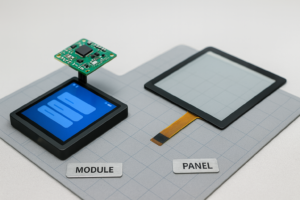Keeping electronic screens clean and protected is essential for ensuring long-term performance and visual clarity. While wiping the surface with a microfiber cloth is often seen as the final step in screen care, true protection begins much earlier—during the design and assembly process.
In this article, we explore practical ways to protect screens from contamination, including dust, water, grease, and microbes. Whether you’re designing industrial touchscreens or consumer displays, these proven strategies will help ensure screen longevity and user satisfaction.
🧼 Clean Rooms: The First Line of Defense
Many screen modules, especially those that integrate touch panels with protective glass, must be assembled in environments where dust and particles are tightly controlled. Ensuring screens are protected from dust, these clean rooms provide such conditions.
A clean room is a dedicated space where the air is filtered and purified to reduce pollutants. According to the ISO 14644-1 standard, clean rooms are rated by cleanliness level. For instance, Unisystem’s facility meets ISO Class 6 requirements, ensuring minimal contamination during display bonding and screen integration.
Tip: Maintaining proper attire and hygiene protocols in clean rooms helps preserve ideal conditions for device assembly.
🧰 Sealing Screens with Proper IP Protection
When designing electronics for outdoor or industrial use, protecting internal components from environmental hazards is crucial. One proven method is using tightly sealed housings with IP-rated enclosures.
The IP (Ingress Protection) rating, as defined by IEC 60529, measures the protection against solids and liquids:
- IP44 – Suitable for bathrooms; protects from particles >1mm and water splashes.
- IP65 – Ideal for industrial use; protects against dust and water jets.
- IP69 – Maximum protection; fully dust- and waterproof, often used in food processing equipment.
Choosing the right gaskets and enclosure design ensures your screens remain unaffected by external contaminants and are well protected from potential contamination.
👣 Say Goodbye to Fingerprints and Glare
While structural protection is essential, surface coatings can also enhance screen hygiene and clarity. Consider the following screen coating options:
- Anti-Reflective (AR) Coating: Reduces glare from sunlight or indoor lighting, improving visibility.
- Anti-Fingerprint (AF) Coating: Adds a smooth surface layer that repels grease and prevents visible smudges.
- Antimicrobial (AM) Coating: Inhibits bacterial growth, making it ideal for public-use screens like kiosks or hospital terminals, thereby helping to protect screens from contamination.
These coatings improve the user experience (UX) while keeping the screen cleaner for longer.
🌍 Environmental Awareness in Design
Understanding the environment in which your display will operate is vital. Whether your screen is exposed to dust, chemicals, or constant touch, integrating protective features during the design phase ensures longer device life and user satisfaction.
Once protection is built-in, maintenance becomes simple. All that’s left is the occasional wipe with a microfiber cloth to maintain clarity and cleanliness.
🧾 Conclusion
To truly protect screens from contamination, designers must consider both hardware protection and surface-level enhancements. From clean rooms and IP-rated enclosures to anti-fingerprint coatings, each layer of protection contributes to better durability, hygiene, and performance.
Ready to upgrade your display design? Contact our team today to explore contamination-resistant screen solutions tailored to your application.
.png)



